Global philanthropy responds to the Ukraine crisis

Since February 24, more than two million people have fled Ukraine. The UN Refugee Agency (UNHCR) head Filippo Grandi described this humanitarian disaster as “the fastest-moving refugee crisis we have seen in Europe since the end of the Second World War”. The United Nations Office for the Coordination of Humanitarian Affairs (OCHA) estimates that some 18 million people will ultimately become affected, including 6.7 million that will be internally displaced and 12 million who will need humanitarian assistance of some kind. Governments have also directed hundreds of millions of dollars in assistance for the Ukraine crisis.
We have been tracking philanthropy’s response to the Russian invasion of Ukraine. Here’s what we know so far.
Overview of findings
- We have identified 208 pledges and grants for Ukraine crisis and relief. This includes 34 pledges worth $241,773,200 and 174 grants worth $343,561,933 as of March 8.
- The United States, United Kingdom, Denmark, the Netherlands, Germany, and Japan account for 91% of total grant funding for Ukraine to date.
- Corporations account for 55% of the total dollar value of grants awarded; foundations and public charities 40%; and high-net-worth individuals for 5%.
- The top five donors by dollar amount—The Conference on Jewish Material Claims Against Germany, IKEA Foundation, BP plc, Lego Foundation, and Google—account for 35% of total funding.
- Little is known about the recipients of this funding. Unknown and multiple recipients received 40% of grants and 62% of total grant funding. Among named recipients, UNHCR received the vast majority of total funding, followed by the International Committee of the Red Cross (ICRC), World Central Kitchen, UNICEF, and Project Hope.
- More than 15% of total grant funding is for the Jewish community in Ukraine.
Details about data on funding for Ukraine crisis humanitarian relief
This analysis and the giving it’s based on is happening in real time. Candid collects data from publicly available sources, including press releases, websites, membership reports and surveys, and local reporting. This data collection includes grants and pledges from institutional and high-net-worth individuals worldwide but does not include the many smaller donations from individuals which account for a significant, if not the primary, source of total philanthropic giving in response to this crisis. It should be noted that our real-time data collection currently relies heavily on sources written in English.
Giving by funder country
This, and the analysis in the tables that follow, focus solely on grants made in response to the crisis.
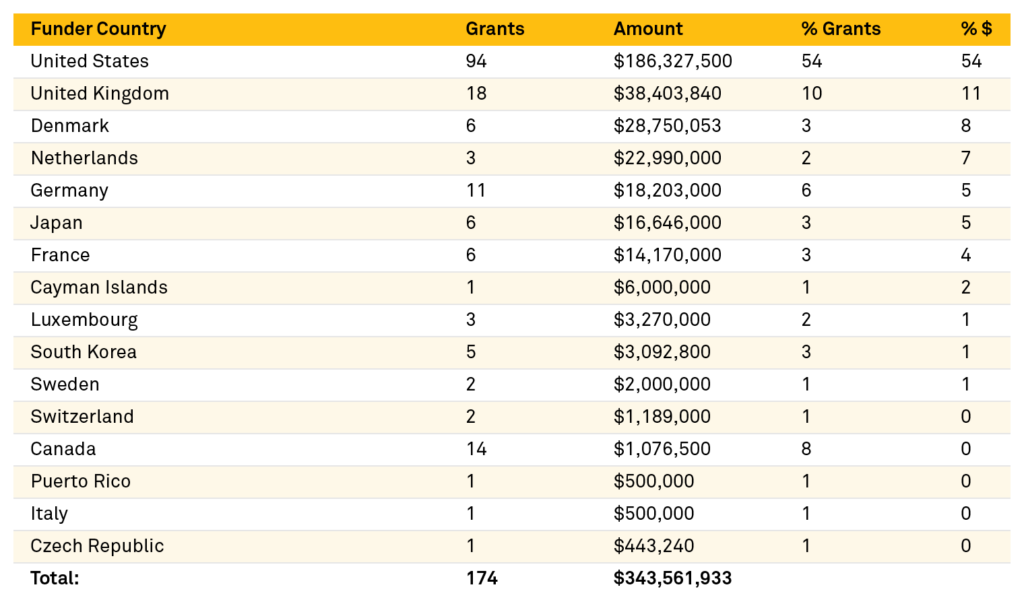
The United States accounts for 54% of total grants and dollar value, followed by the United Kingdom, Denmark, and the Netherlands, which together account for 15% of grants and 26% of total dollar value.
Giving by funder type

Corporate giving programs account for 59% of grants and 55% of total dollar value, while foundations and public charities account for 36% of grants and 40% of total dollar value. High-net-worth individuals contributed 5% of grants and total dollar value.
Giving by top funders
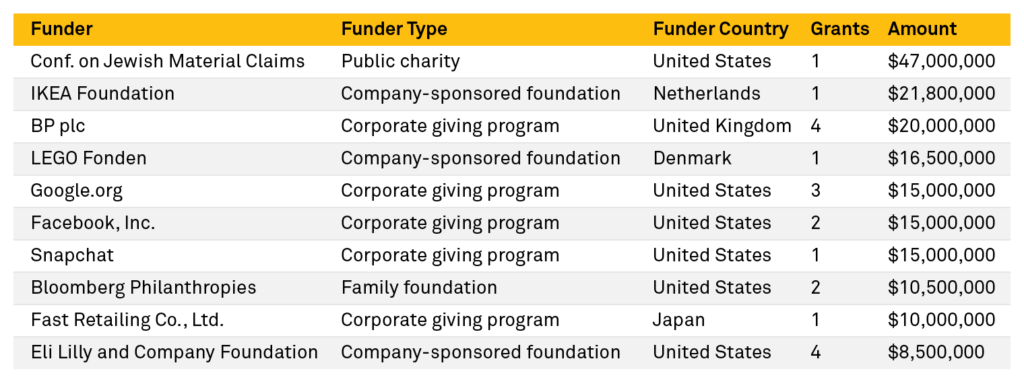
The top 10 funders account for 54% of total funding for Ukraine.
Top recipients
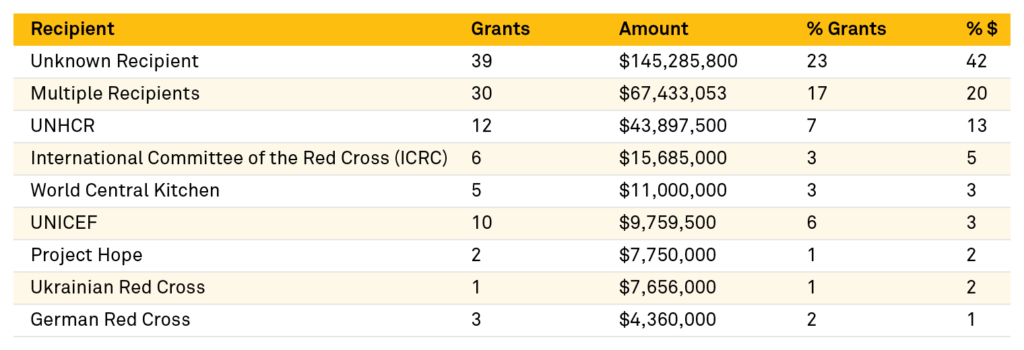
The top 10 recipients account for 66% of grants and 92% of total grant dollar value. In keeping with what we’ve seen in past crisis responses, the lion’s share of grants is going to unnamed recipients, with unknown and multiple recipients receiving 40% of all grants and 62% of total dollar value. Candid uses the label “Unknown recipient” when we have no information about the recipient of funding. Candid uses “Multiple recipients” when the recipients of funding are known, but the exact amount going to each recipient is not known. Among named recipients, UNHCR received the most grants, followed by the International Committee of the Red Cross (ICRC) and World Central Kitchen.
Pledges by funder type
Typically, in the early days of a response to crises and natural disasters, more than a few donations will be in the form of pledges (announcements of intent to make a monetary or in-kind contribution of specified value, paid in a lump sum or over time). We capture and report on pledges to provide a more complete picture of the scope of a given philanthropic response, but we clearly distinguish between these promises to pay (pledges) and funds actually disbursed or committed to specific organizations (grants). Below are pledges by funder type:

Corporations account for 59% of pledges for the Ukraine crisis and relief and 64% of the total dollar value of those pledges. Foundations and charities account for 35% of pledges and 38% of total dollar value.
At Candid, we wonder: how do real-time analyses inform and shape the response that follows? As a nonprofit ourselves, we are navigating new landscapes for giving, and thinking deeply about the implications of funding patterns for a wide range of organizations. We’ll keep sharing what we know, in hopes that funders can use the data to better inform their giving. We also call on funders to share data about their grantmaking in response to the crisis to ensure that the community is acting on the most comprehensive and accurate information possible. For additional information about sharing your data, please email [email protected].

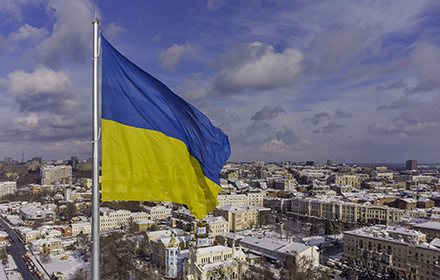
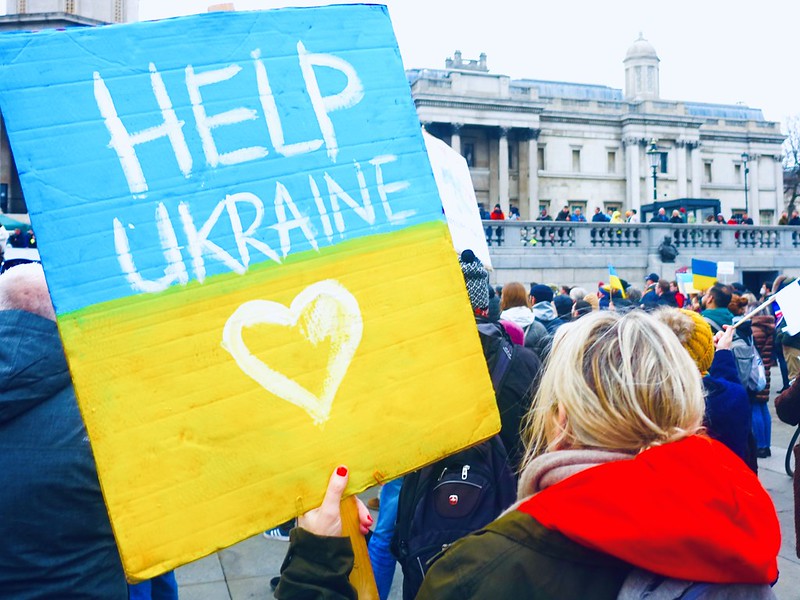



David Dzidzikashvili says:
At the end of 1990s Putin became the leader of Russia by staging his first KGB style military operation – bombing Moscow apartment buildings to gain popularity and re-start the war in Chechnya. Putin killed his own innocent civilians, hundreds of Russians in order to boost his popularity and gather more war support. The US, EU and NATO should have seen his true face then, but decided to ignore Putin's Chechnya war crimes and welcomed Putin to red carpet meetings and Bush even declared his trust in Putin. This further emboldened Putin who had suppressed all democratic processes internally in Russia and has successfully become a dictator and tyrant.
Putin's first test run to settle his political goals with military adventures and military operations was in Georgia in 2008. In August 2008 Putin attacked Georgia's Samachablo and Abkhazian regions and successfully annexed territories of a sovereign country. What did the US and EU do? Obama administration decided to do reset policy with Russia – greatest mistake of President Obama and Angela Merkel, who kept closest relations with Putin and did not want to upset Putin. Russia was not even hit with bare minimum of sanctions for conquering Georgia's two regions.
This further encouraged Putin to find more military solutions to his political issues and goals. As Georgia's President Mikheil Saakashvili said “Ukraine, Crimea will be the next!" the EU leaders laughed at him. In 2014 the new reality sets in РPutin did order and conquered Crimea and Eastern Ukrainian regions. At that time the Obama administration and Angela Merkel received first reality check from Putin, but they made the second greatest mistake with Putin: They set bare minimum of sanctions, did not punish Putin for violating the international laws and let him get away again!
This has turned Putin into a strong dictator backed by US dollars and EU Euros for the Russian energy exports (oil & gas), with more money going $$$ in his pockets as the crude oil prices went up, Putin was able to order more military adventures to settle his political objectives. In Syria Putin had committed number of atrocities against civilians and used chemical weapons. What consequences did he face? Absolutely nothing, verbal condemnation by the international community.
And now we are in 2022. Post WW2, this is the third time (after Georgia in 2008, Ukraine 2014) Putin had ordered massive invasion and the war of conquest of a sovereign country. Suddenly the world woke up to new reality. However, the reality was established during the 1990s when Putin planned and executed the Moscow apartment bombings, the US/EU/NATO decided to ignore the warning signs and tried to welcome Putin into the international community.
What is happening now in Ukraine should be the wake up call to the entire world. The post World War 2 international system & the world order has been shattered to pieces and international law had been completely ignored without any consequences by Putin again and again.
What Ukraine needs is the world to come to terms with reality: Putin has to be defeated and the establishment/elite power structure of the Kremlin has to change. Before this happens, the Ukrainian military MUST receive all necessary lethal defensive and offensive weapons as well.
The Ukrainians need to have anti-air capability to shoot down incoming missiles and airplanes from much higher altitudes, so the S-300/S-400 systems will be much welcome, however this is not enough. The Ukrainian army needs those MIG29s to enforce its own No Fly Zone, since the western powers are too scared to face Putin over even a limited No Fly Zone over humanitarian corridor. So lets give this power to the Ukrainians?
What the Ukrainian side needs is Patriot missile systems as well and anti-artillery systems: radars, locators and smart artillery systems from the US.
The above-mentioned weapons systems would have an immediate impact on the ground and will change the formula on the ground by giving Ukrainians much needed upper hand to control the air and protect the civilians from the #1 major killers: incoming artillery shells and missiles.
Slava Ukraini! Glory to Ukraine!
David Dzidzikashvili
Ph.D. Candidate
Business & Technology University – BTU
Tbilisi, Georgia